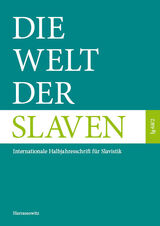Autor: Вадим Б. Крысько (Vadim B. Krysko)
- «
- 1
- »
Die Suche erzielte 5 Treffer.
Жалованная грамота княз я Владислава Опольского Даниле Дажбоговичу 1375 г. article
Лáврошевское евангелие и его экстратексты article
Мучение Ирины – переводное житие древнейшего периода славянской письменности article
К новому изданию Успенского сборника article
- «
- 1
- »
